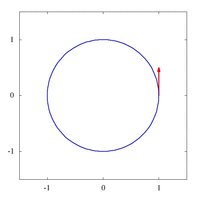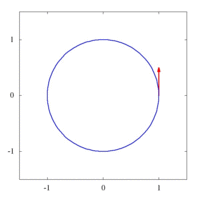Levi-Civita connection
In Riemannian geometry, the Levi-Civita connection is a specific connection on the tangent bundle of a manifold. More specifically, it is the torsion-free metric connection, i.e., the torsion-free connection on the tangent bundle (an affine connection) preserving a given (pseudo-)Riemannian metric.
The fundamental theorem of Riemannian geometry states that there is a unique connection which satisfies these properties.
In the theory of Riemannian and pseudo-Riemannian manifolds the term covariant derivative is often used for the Levi-Civita connection. The components of this connection with respect to a system of local coordinates are called Christoffel symbols.
History
The Levi-Civita connection is named after Tullio Levi-Civita, although originally "discovered" by Elwin Bruno Christoffel. Levi-Civita,[1] along with Gregorio Ricci-Curbastro, used Christoffel's symbols[2] to define the notion of parallel transport and explore the relationship of parallel transport with the curvature, thus developing the modern notion of holonomy.[3]
The Levi-Civita notions of intrinsic derivative and parallel displacement of a vector along a curve make sense on an abstract Riemannian manifold, even though the original motivation relied on a specific embedding
since the definition of the Christoffel symbols make sense in any Riemannian manifold. In 1869, Christoffel discovered that the components of the intrinsic derivative of a vector transform as the components of a contravariant vector. This discovery was the real beginning of tensor analysis. It was not until 1917 that Levi-Civita interpreted the intrinsic derivative in the case of an embedded surface as the tangential component of the usual derivative in the ambient affine space.
Notation
- (M, g) denotes a Riemannian or pseudo-Riemannian manifold.
- TM is the tangent bundle of M.
- g is the Riemannian or pseudo-Riemannian metric of M.
- X, Y, Z are smooth vector fields on M, i. e. smooth sections of TM.
- [X, Y] is the Lie bracket of X and Y. It is again a smooth vector field.
The metric g can take up to two vectors or vector fields X, Y as arguments. In the former case the output is a number, the (pseudo-)inner product of X and Y. In the latter case, the inner product of Xp, Yp is taken at all points p on the manifold so that g(X, Y) defines a smooth function on M. Vector fields act as differential operators on smooth functions. In a basis, the action reads
- ,
where Einstein's summation convention is used.
Formal definition
An affine connection ∇ is called a Levi-Civita connection if
- it preserves the metric, i.e., ∇g = 0.
- it is torsion-free, i.e., for any vector fields X and Y we have ∇XY − ∇YX = [X,Y], where [X,Y] is the Lie bracket of the vector fields X and Y.
Condition 1 above is sometimes referred to as compatibility with the metric, and condition 2 is sometimes called symmetry, cf. DoCarmo's text.
Assuming a Levi-Civita connection exists it is uniquely determined. Using conditions 1 and the symmetry of the metric tensor g we find:
By condition 2 the right hand side is equal to
so we find
Since Z is arbitrary, this uniquely determines ∇XY. Conversely, using the last line as a definition one shows that the expression so defined is a connection compatible with the metric, i.e. is a Levi-Civita connection.
Christoffel symbols
Let ∇ be the connection of the Riemannian metric. Choose local coordinates and let be the Christoffel symbols with respect to these coordinates. The torsion freeness condition 2 is then equivalent to the symmetry
The definition of the Levi-Civita connection derived above is equivalent to a definition of the Christoffel symbols in terms of the metric as
where as usual are the coefficients of the dual metric tensor, i.e. the entries of the inverse of the matrix .
Derivative along curve
The Levi-Civita connection (like any affine connection) also defines a derivative along curves, sometimes denoted by D.
Given a smooth curve γ on (M,g) and a vector field V along γ its derivative is defined by
Formally, D is the pullback connection on the pullback bundle γ*TM.
In particular, is a vector field along the curve γ itself. If vanishes, the curve is called a geodesic of the covariant derivative. Formally, the condition can be restated as the vanishing of the pullback connection applied to :
If the covariant derivative is the Levi-Civita connection of a certain metric, then the geodesics for the connection are precisely those geodesics of the metric that are parametrised proportionally to their arc length.
Parallel transport
In general, parallel transport along a curve with respect to a connection defines isomorphisms between the tangent spaces at the points of the curve. If the connection is a Levi-Civita connection, then these isomorphisms are orthogonal – that is, they preserve the inner products on the various tangent spaces.
The images below show parallel transport of the Levi-Civita connection associated to two different Riemannian metrics on the plane, expressed in polar coordinates. The metric of left image corresponds to the standard Euclidean metric, while the right metric has standard form in polar coordinates, and thus preserves the vector tangent to the circle. This metric has a singularity at the origin in Euclidean coordinates.


Example: The unit sphere in R3
Let be the usual scalar product on R3. Let S2 be the unit sphere in R3. The tangent space to S2 at a point m is naturally identified with the vector sub-space of R3 consisting of all vectors orthogonal to m. It follows that a vector field Y on S2 can be seen as a map Y: S2 → R3, which satisfies
Denote by dmY(X) the covariant derivative of the map Y in the direction of the vector X. Then we have:
Lemma: The formuladefines an affine connection on S2 with vanishing torsion.
Proof: It is straightforward to prove that ∇ satisfies the Leibniz identity and is C∞(S2) linear in the first variable. It is also a straightforward computation to show that this connection is torsion free. So all that needs to be proved here is that the formula above does indeed define a vector field. That is, we need to prove that for all m in S2
Consider the map f that sends every m in S2 to <Y(m), m>, which is always 0. The map f is constant, hence its differential vanishes. In particular
The equation (1) above follows.
In fact, this connection is the Levi-Civita connection for the metric on S2 inherited from R3. Indeed, one can check that this connection preserves the metric.
See also
Notes
References
Primary historical references
- Christoffel, Elwin Bruno (1869), "Über die Transformation der homogenen Differentialausdrücke zweiten Grades", J. für die Reine und Angew. Math., 70: 46–70
- Levi-Civita, Tullio (1917), "Nozione di parallelismo in una varietà qualunque e consequente specificazione geometrica della curvatura Riemanniana", Rend. Circ. Mat. Palermo, 42: 73–205, doi:10.1007/bf03014898
Secondary references
- Boothby, William M. (1986). An introduction to differentiable manifolds and Riemannian geometry. Academic Press. ISBN 0-12-116052-1.
- Kobayashi, S.; Nomizu, K. (1963). Foundations of differential geometry. John Wiley & Sons. ISBN 0-470-49647-9. See Volume I pag. 158
- Spivak, Michael (1999). A Comprehensive introduction to differential geometry (Volume II). Publish or Perish Press. ISBN 0-914098-71-3.
External links
- Hazewinkel, Michiel, ed. (2001), "Levi-Civita connection", Encyclopedia of Mathematics, Springer, ISBN 978-1-55608-010-4
- MathWorld: Levi-Civita Connection
- PlanetMath: Levi-Civita Connection
- Levi-Civita connection at the Manifold Atlas